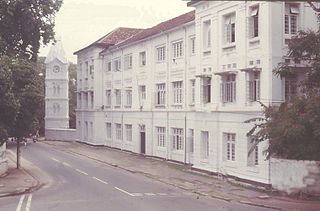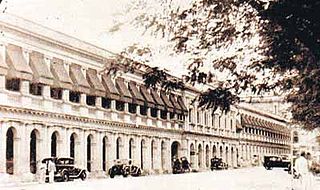Related Research Articles

The Parliament of the Democratic Socialist Republic of Sri Lanka is the supreme legislative body of Sri Lanka. It alone possesses legislative supremacy and thereby ultimate power over all other political bodies in the island. It is modeled after the British Parliament. The 17th Parliament of Sri Lanka will convene for the first time on 21 November 2024.

The governor-general of Ceylon was the representative of the Ceylonese monarch in the Dominion of Ceylon from the country's independence in 1948 until it became the republic of Sri Lanka in 1972.

Ceylon Medical College was a public medical school in Ceylon. The college was established in 1870 as the Colombo Medical School. The college was based in Colombo. The college was merged with Ceylon University College in 1942 to form the University of Ceylon. The medical college became the university's faculty of medicine. The college was also known as Colombo Medical College.
The Ceylon Civil Service, popularly known by its acronym CCS, was the premier civil service of the Government of Ceylon under British colonial rule and in the immediate post-independence period. Established in 1833, it functioned as part of the executive administration of the country to various degrees until Ceylon gained self-rule in 1948. Until it was abolished on 1 May 1963 it functioned as the permanent bureaucracy or secretariat of Crown employees that assisted the Government of Ceylon.
In Sri Lanka, the Cabinet of Ministers is the council of senior ministers responsible and answerable to the Parliament of Sri Lanka. The President is a member of the cabinet and its head.

The Speaker of the Parliament of the Democratic Socialist Republic of Sri Lanka is the presiding officer of the chamber. The Speaker fulfills a number of important functions in relation to the operation of the House, which is based upon the British Westminster parliamentary system. The speaker is second in the Sri Lankan presidential line of succession, after the prime minister.
The Order of Precedence in Sri Lanka the protocol list at which Sri Lankan government officials are seated according to their rank. This is not the list of succession.

The Legislative Council of Ceylon was the legislative body of Ceylon established in 1833, along with the Executive Council of Ceylon, on the recommendations of the Colebrooke-Cameron Commission. It was the first form of representative government in the island. The 1931 Donoughmore Constitution replaced the Legislative Council with the State Council of Ceylon.
The chief justice of the Democratic Socialist Republic of Sri Lanka is the head of the judiciary of Sri Lanka and the Supreme Court of Sri Lanka. Established in 1801, the chief justice is one of ten Supreme Court justices; the other nine are the puisne justices of the Supreme Court of Sri Lanka. The post was created in 1801. The chief justice is nominated by the Constitutional Council, and appointed by the president. The first chief justice was Codrington Edmund Carrington. The current chief justice is Murdu Nirupa Fernando.
The Executive Council of Ceylon was the executive council created in Ceylon by the British colonial administration on the recommendations of the Colebrooke-Cameron Commission along with the Legislative Council of Ceylon in March 1833.
The Ministry of Finance, Economic Stabilization and National Policies is a cabinet ministry of the Government of Sri Lanka responsible for developing and executing the government's public finance policy, economic policy and long term fiscal planning. The Treasury is housed at the General Treasury Building in Fort.
Queen's Cottage is a country house near Nuwara Eliya, Sri Lanka. It is the vacationing and country residence of the President of Sri Lanka. Located within the limits of the Nuwara Eliya Municipal Council along the Queen Elizabeth Drive, it is a protected monument under the Antiquities Ordinance.
Bernard Percival Peiris, OBE, JP was a Sri Lankan lawyer. He was the former Cabinet Secretary and the Legal Draftsmen who drafted the Ceylon Order in Council, the first constitution of independent Ceylon.

The prime minister of Sri Lanka, officially the prime minister of the Democratic Socialist Republic of Sri Lanka is the most senior member of parliament in the cabinet of ministers. It is the second-most powerful position in Sri Lanka's executive branch behind the president, who is the constitutional chief executive. The Cabinet is collectively held accountable to parliament for their policies and actions. The powers and functions of the Prime Minister has changed several times since the creation of the office in 1947.
Thomas Eden, was the Secretary to the Governor of Ceylon, Treasurer of Ceylon (1816–1822), Commissioner of Stamps, and a member of the Executive and Legislative Councils.
The Legal Secretary of Ceylon, was an officer of state of the British Colonial Administration of Ceylon from 1931 to 1947, appointed from the Colonial Legal Service. The Legal Secretary one of three officers of state of the Board of Ministers of the State Council of Ceylon, who serve as the legal advisor to the government; administration of justice; criminal prosecutions and civil proceeding on behalf of the crown; election to the State Council, drafting of legislature and the public trustee. The post was formed under recommendations of the Donoughmore Commission the post replaced the Attorney General as the chief legal advisor to the Governor, it was in turn replaced by the post of Minister of Justice in 1947 under the recommendations of the Soulbury Commission under the Ceylon Independence Act, 1947 and The Ceylon Orders in Council 1947.
The Financial Secretary of Ceylon was an officer of the Ceylonese Government and member of the Board of Ministers. The Treasurer of Ceylon was one of six offices that held a seat in the Executive Council of Ceylon from 1809 to 1932. The post was replaced by the that of Financial Secretary in 1932, as one of three officers of state of the new Board of Ministers that replaced the Executive Council under recommendations of the Donoughmore Commission. The Financial Secretary was in turn replaced by the new office of the Minister of Finance in 1947 under the recommendations of the Soulbury Commission under the Ceylon Independence Act, 1947 and The Ceylon Orders in Council 1947.
Austin Woodeson was a British architect, who served as the Chief Architect in Ceylon.
References
- 1 2 Wrigh, Arnold (1999). Twentieth Century Impressions of Ceylon. Asian Educational Services. ISBN 9788120613355 . Retrieved 22 March 2014.
- 1 2 Mills, Lennox A (12 November 2012). Ceylon Under British Rule 1795-1932. Routledge. ISBN 9781136262715 . Retrieved 22 March 2014.
- ↑ Ubeywarna, D. L. (14 February 2004). "Lanka's journey to Independence, in retrospect: Impact of constitutional developments on nation - making". Daily News (Sri Lanka) .
- ↑ "1942 Ferguson's Ceylon Directory". Ferguson's Directory. Retrieved 30 July 2021.
- ↑ "Evolution of the Office of the Attorney General in Sri Lanka". attorneygeneral.gov.lk. Archived from the original on 30 July 2021. Retrieved 30 July 2021.
- ↑ Ferguson, John (1887). Ceylon in the "jubilee Year". J. Haddon and Co. pp. 256-7.
- ↑ Ceylon: Its History, People, Commerce, Industries and Resources. Plâté limited. 1924. pp. 100–1. Retrieved 27 April 2016.
- ↑ "Sir Robert Drayton Dies" . Retrieved 22 October 2020.